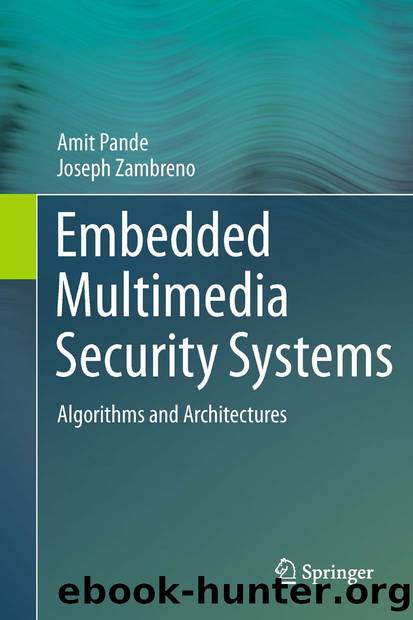Embedded Multimedia Security Systems by Amit Pande & Joseph Zambreno

Author:Amit Pande & Joseph Zambreno
Language: eng
Format: epub
Publisher: Springer London, London
5.1 Introduction
The recent emergence of embedded multimedia applications such as mobile-TV, surveillance, video messaging, and tele-medicine have increased the scope of multimedia in our personal lives. These applications increase the concerns regarding privacy and security of the targeted subjects. Another growing concern is the protection and enforcement of intellectual property rights for images and videos. These and other issues such as image authentication, rights validation, identification of illegal copies of a (possibly forged) image are grouped and studied under the label of Digital Rights Management (DRM).
The computer security protocols (e.g. SSL [36], TLS [4]) and cryptographic ciphers (e.g. AES [10], DES [11], IDEA [18]) drive much of the world’s electronic communications, commerce, and storage. These techniques have been used for conventional multimedia encryption and authentication.
In one version of these schemes, some form of private-key encryption algorithm is applied over the full or partial output bit stream from the video compression engine. This naive approach is usually suitable for text, and sometimes for small bitrate audio, image, and video files that are being sent over a fast dedicated channel. Secure Real-time Transport Protocol, or for short SRTP [2], is an application of the naive approach. In SRTP, multimedia data are packetized and each packet is individually encrypted using AES. The naive approach enables the same level of security as that of the used conventional cryptographic cipher.
Consequently, a multimedia compression engine (such as a MPEG or H.264 encoder [34]) has an additional encryption engine to ensure multimedia security. Depending on the scheme used, the encryption operation is performed either at some intermediate level during compression or after the final compression. However, these cryptographic ciphers require a large amount of computational resources and often incur large latencies. Hardware implementations of AES are often pipelined, leading to a significantly large latency for real-time applications (31 cycles for AES [14]). The partial or selective encryption schemes [21] encode only the important parts of multimedia data to reduce these computational overheads.
The large data volumes, interactive operations, real-time responses, and scalability features that are inherent to real-time multimedia delivery restrict the practical application of these naive cryptographic schemes. Selective encryption schemes have been proposed in research literature [3, 9, 19, 21, 26] to reduce the computational requirements of full encryption schemes. Lian et al. [19] present a scheme for encryption of Discrete Cosine Transform (DCT) coefficients’ signs and watermarking of DCT coefficients. Lian et al. [19] use Exp-Goloumb codes for the encryption operation. Cheng and Li [6] propose a DWT-based partial encryption scheme which encrypts only a part of compressed data. Only 13–27 % of the output from quadtree compression algorithms is encrypted for typical images. A good summary of efforts in selective or partial encryption of images can be found in [21].
Furthermore, embedded multimedia systems have constraints on power consumption, available computation power, and performance. Real-time embedded systems face additional constraints on power consumption, hardware size and heat generation in the chip which requires design and mapping of computation-savvy encryption schemes for such architectures. Recently, power-aware designs have been proposed for video coding in embedded scenarios [5].
Download
This site does not store any files on its server. We only index and link to content provided by other sites. Please contact the content providers to delete copyright contents if any and email us, we'll remove relevant links or contents immediately.
Sass and Compass in Action by Wynn Netherland Nathan Weizenbaum Chris Eppstein Brandon Mathis(7909)
Autodesk Civil 3D 2024 from Start to Finish by Stephen Walz Tony Sabat(7034)
Mathematics for Game Programming and Computer Graphics by Penny de Byl(6949)
Taking Blender to the Next Level by Ruan Lotter(6739)
Express Your Creativity with Adobe Express by Rosie Sue(6539)
Hands-On Unity 2022 Game Development - Third Edition by Nicolas Alejandro Borromeo(6153)
Hands-On Unity 2022 Game Development by Nicolas Alejandro Borromeo(5022)
Unreal Engine 5 Character Creation, Animation, and Cinematics by Henk Venter & Wilhelm Ogterop(3908)
Going the Distance with Babylon.js by Josh Elster(3874)
Mastering Graphics Programming with Vulkan by Marco Castorina & Gabriel Sassone(3755)
Squeaky Clean Topology in Blender by Michael Steppig(3750)
Adobe Illustrator for Creative Professionals by Clint Balsar(3727)
Drawing Shortcuts: Developing Quick Drawing Skills Using Today's Technology by Leggitt Jim(2954)
Unreal Engine 5 Character Creation, Animation, and Cinematics by Henk Venter Wilhelm Ogterop(2899)
Rapid Viz: A New Method for the Rapid Visualization of Ideas by Kurt Hanks & Larry Belliston(2786)
The 46 Rules of Genius: An Innovator's Guide to Creativity (Voices That Matter) by Marty Neumeier(2717)
Learn Qt 5: Build modern, responsive cross-platform desktop applications with Qt, C++, and QML by Nicholas Sherriff(2386)
Fusion 360 for Makers by Lydia Sloan Cline(2256)
Hands-On Neural Networks with Keras by Niloy Purkait(2203)
